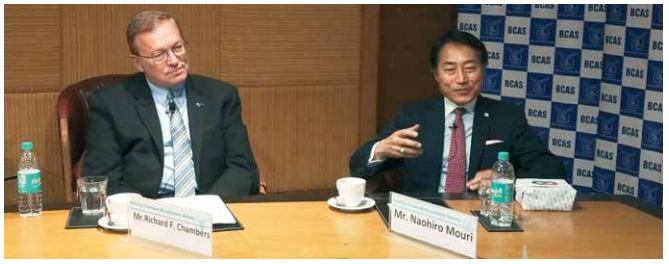fiogf49gjkf0d
New Page 2
(Full texts of the following Tribunal decisions are available
at the Society’s office on written request. For members desiring that the
Society mails a copy to them, Rs.30 per decision will be charged for
photocopying and postage.)
Part B : UNREPORTED DECISIONS
17 DCIT v. Bank of Bahrain &
Kuwait
ITAT ‘C’ Bench, Mumbai (SB)
Before D. Manmohan (VP),
S. V. Mehrotra (AM) and D. K.
Agarwal (JM)
ITA Nos. 4404 & 1883/Mum./2004
A.Ys. : 1999-2000 & 1998-99
Decided on : 13-8-2010
Counsel for revenue/assessee :
Ajit Kumar
Sinha/F. V. Irani
Income-tax Act, 1961 — S. 28, S.
37 — Exchange fluctuation loss in respect of unmatured forward contracts on the
last date of the accounting period on the basis of rate of foreign exchange
prevailing on that date is allowable as a deduction.
Per S. V. Mehrotra :
Facts :
The assessee was a non-resident
company carrying on banking business in India. It entered into forward contracts
with its clients to buy or sell foreign exchange at an agreed price on a future
date. On the date of maturity, the execution of the contract resulted in profits
or losses to the assessee. There was no dispute as regards losses arising on
execution of the contracts within the same year. However, in cases where the
date of maturity of the contract fell beyond the end of the accounting period,
the assessee evaluated the unmatured forward contract on the last day of the
accounting period on the basis of rate of foreign exchange prevailing on that
date and booked the profit or loss accordingly. The Assessing Officer (AO) taxed
the profit so booked but did not allow the assessee’s claim of loss, by relying
on the decision of the Madras High Court in the case of Indian Overseas Bank
(183 ITR 200), on the ground that the loss is incurred on the date of maturity
of the contract and there cannot be any loss prior to such date. In other words,
he held such loss to be notional.
Aggrieved the assessee preferred
an appeal to the Commissioner of Income-tax (Appeals) who allowed the assessee’s
appeal.
Aggrieved the Revenue preferred
an appeal to the Tribunal.
The assessee supported its claim
by relying on the decision of the Mumbai Tribunal in the case of Deutsche Bank
A.G., 86 ITD 431 (Mum.). The Tribunal noted that in the case of Deutsche Bank
(supra) the decision of the Madras High Court was distinguished on the ground
that the Court was concerned with the issue as to whether notional or
anticipated loss could be allowed as deduction or not, while the Tribunal was
concerned with the valuation of stock-in-trade. The Bench referred the matter,
since the assessee, as a banker, only entered into contract to sell/buy the
foreign currency at a future date, but did not buy or sell such contracts from
or in the market. It observed that the assessee was not holding these contracts
as stock-in-trade and, therefore, the decision in the case of Deutsche Bank was
not applicable.
The Bench framed the following
question of law for reference :
“Whether on facts and
circumstances of the case, can it be said that where a forward contract is
entered into by the assessee to sell the foreign currency at an agreed price at
a future date falling beyond the last date of accounting period, the loss is
incurred to the assessee on account of evaluation of the contract on the last
date of the accounting period i.e., before the date of maturity of the forward
contract.”
Held :
The Special Bench of the
Tribunal decided this ground in favour of the assessee and held :
(1) Deduction is allowable
under the Act in respect of those liabilities which crystalise during the
previous year. Therefore, the concept of crystalisation of liability under
the Income-tax Act assumes significance vis-à-vis commercial principles in
vogue. As per the commercial principles of policy of prudence, all
anticipated liabilities have to be accounted, but as per Income-tax Act,
only that liability will be allowed which has actually accrued. Due
weightage must be given to commercial principles in deciding such issues.
(2) Anticipated liabilities
which are contingent in nature are not allowable, but if an anticipated
liability is coupled with present obligation and only quantification can
vary depending upon the terms of the contract, then a liability is said to
have crystalised on the balance sheet date.
(3) A contingent liability
depends purely on the happening or not happening of an event, whereas if an
event has already taken place, which, in the present case, is of entering
into the contract and undertaking of obligation to meet the liability, and
only consequential effect of the same is to be determined, then, it cannot
be said that it is in the nature of contingent liability.
4. The issues relating to accrual of income cannot be decided on the same footing and considerations on which the issues relating to loss/expense is to be decided. In case of loss/expense, it is the concept of reasonable certainty to meet an existing obligation which comes into play which in legal terminology is said to be ‘crystalisation of liability’. When outflow of economic resources in settlement of present obligation can be anticipated with reasonable accuracy, then it is to be recognised as a crystallised liability. This is in consonance with the principle of prudence as considered by the Supreme Court in the case of Woodward Governor of India Pvt. Ltd.
5. The Revenue’s contention that liability can arise only when contract matures is completely divorced of principles of commercial accounting and, therefore, cannot be accepted. Both legal obligation and commercial principles have to be taken into consideration for deciding such issues.
6. The anticipated losses on account of existing obligation on 31st March, determinable with reasonable accuracy, being in the nature of expenditure/accrued liability, have to be taken into account while preparing financial statements.
7. The elements of financial statement can be broadly divided into the following five groups, viz. assets, liabilities, equity, income/gains and expenses/loss. These items are recognised in a financial statement if both the following criteria are met :
a) future economic benefit will be there from the said events,
b) the event can be measured in monetary terms.
In the present case, the AO himself has observed in the assessment order that at the time of entering into the contract, the assessee has recorded the income/loss on the basis of difference between the contracted rate and spot rate. Thus, to say that the contract was incapable of being recognised in the books of account, is not correct. The assessee recorded only the net effect of the transaction and not the entire transaction. Whether the deduction is allowable or not, therefore, cannot be guided by this factor.
8. The AO cannot reject the method of accounting followed by the assessee merely on the ground that a better method of accounting could be the alternate one. However, in the present case, though observations have been made by the AO to this effect, but actual disallowance has been made by treating the impugned amount as contingent liability.
9. Accounting Standard 11 issued by ICAI is mandatory and mandates that in a situation like in the present case, since the transaction is not settled in the same accounting period, the effect of exchange difference has to be recorded on 31st March.
10. The foreign exchange currency held by the assessee bank is its stock-in-trade. On facts, this contract was incidental to the assessee’s holding of the foreign currency as current assets. Therefore, in substance, it cannot be said that the forward contract had no trappings of stock-in-trade.
11. Profits are considered only when actual debt is created in favour of the assessee, but in case of anticipated losses, if an existing binding obligation, though dischargeable at a future date, is determinable with reasonable certainty, then the same is allowable.
12. The principle that the liability in paraesenti is an allowable deduction but a liability in futuro, which for the time being is only contingent is not allowable has to be applied keeping in view the principles of prudence and applicable Accounting Standards.
13. When profits are being taxed by the Department in respect of such unmatured foreign exchange contracts, then there was no reason to disallow the loss as claimed by the assessee in respect of the same contracts on the same footing.









